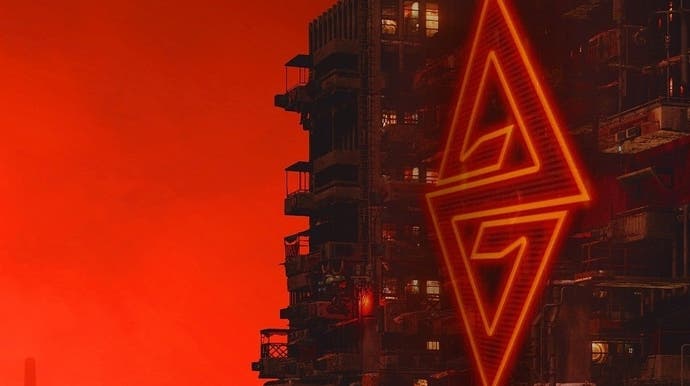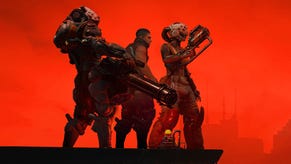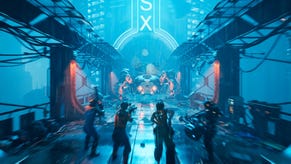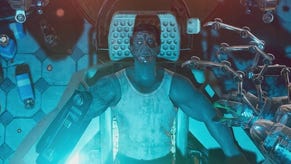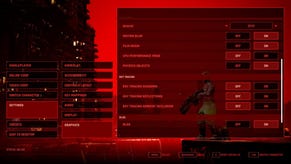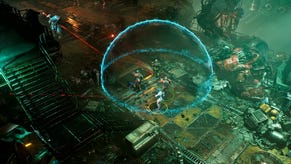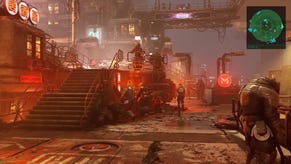The Ascent review - a breathtaking cyberpunk world in thrall to a tedious RPG-shooter
Social climber.
The Ascent teems. Its tiered alien megacity is one of the liveliest cyberpunk settings I've explored, always crawling with people and machines, whether you're massacring mutants in the sewers or gazing out from a boardroom window. Admittedly, it also teems with cliches and callouts to the usual canonical works: William Gibson's phrase "high tech, low life", which flickers on displays throughout like a sorcerer's incantation; Blade Runner's flourescent umbrella handles and melancholy synth score; pirouetting holostrippers from any number of seedy sci-fi saloons; an Oriental faction who worship honour and wield katanas. This is not one of your transgressive, norm-busting punk fictions - even Ruiner, its closest cousin, is a bolt from the blue by comparison. But what The Ascent's world lacks in imagination and bite it almost makes up for in scale and an exhaustive, toymaker's commitment to the fine details.
Take the shops. It's probably the lockdown talking, but I want to live in them. Seriously, you never saw such shops! Armouries fringed by spinning, wireframe weapons. Soylent-green pharmacies and 24 hour kiosks with the fading aura of an impending hangover. Fortified holes-in-the-wall staffed by philosophical robots. Open air markets of steam, textile and clanking metal. Each store is a delicate little treasure box, the lid peeling away when you step inside - neatly patterned with wares, like chips filling a circuit board. And how about that lighting? Polluted, gauzy, shifting, overwhelming. The arcology's hub districts are a battle royale of adboards and Hangul script, a chaos of screens and reflections filtered through smog, the interweaving paths of delivery drones and the shuffling bodies of hundreds of weary NPCs. It's easy to get lost, even when following the breadcrumb trail laid out by the HUD, and I don't mind one bit. The Ascent's city is catnip for digital flâneurs. It craves to be idled in.
The elevated diagonal perspective does a lot of work here, producing a landscape of corners that split the setting into lush, contrasting arrangements of colours and textures. There's a base level of visual fascination to the way floor patterns and buildings map to, or tug against the axes of shooting and exploration suggested by the quasi-isometric viewpoint. The vertical city premise is a bit sleight-of-hand: the world is functionally a series of flat planes linked by loading transitions, one that doesn't even see the need for a jump button. But the game ably cultivates the impression of colossal depth. Chance gaps and reinforced glass floors offer giddy views of hovercars slicing through disorderly canyons of tenements and factories, hundreds of metres beneath. Some of these depths can be accessed by elevator or floating platform - transitions reminiscent of Abe's Oddysee's fore-to-background shifts - but enormous effort has been spent bringing life to places that can't be reached. You'll spot showers of sparks from droids fixing the flanks of walkways, and balconies stuffed with party-goers, just above the navigable plane.
So what do you do in this astonishing setting - the work, would you believe, of a dozen developers? Having blown three paragraphs raving about kiosks, let me see if I can cram everything into a sentence: follow HUD prompts to a quest marker, circle-strafe away from attackers till everybody is toast, spend your level-up points and make for the next objective, perhaps stopping en-route to upgrade or sell off some gear if you pass a vendor. That's the game. OK, not quite: there's also hacking, but it's a glorified gating feature/back-tracking incentive, with beefier cyberdecks letting you crack encrypted treasure chests and disable the forcefields that separate city districts.
It's a horrible waste of a setting. It's also a waste of a story. The writing is routine cyberpunk fare: overcompensatory c0rpoSlang and edgy self-interest, with characters ranging from an apoplectic crime boss to a wintry mercenary captain - Hitman's Diana Burnwood after a trip to the ripperdoc. These garrulous souls aren't so much personalities as grab-bags of attitudes harvested from TVtropes. But the narrative premise is quite intriguing. Most of The Ascent's citizens are indents, interplanetary pioneers who must now spend their whole lives paying off the cost of travel. As the game begins, the corporation running the arcology has mysteriously gone bankrupt, which means that everybody's contracts are in limbo, together with ownership of utilities such as the AIs and power generators at the bottom of the world.
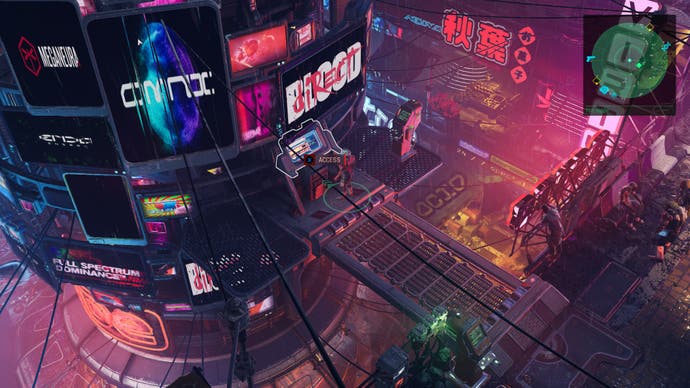
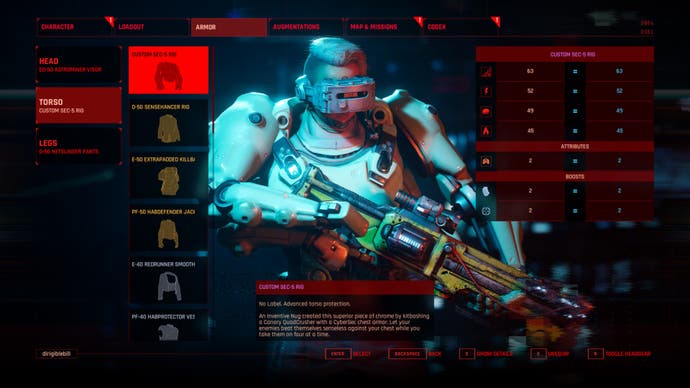

It's a breath of possibility in a place that has operated for decades as an overblown debtor's prison, cue hushed conversations in the streets between burned-out labourers who once dreamed of building paradise. There's little expectation of positive change - everybody understands from the off that some or other big firm will eventually seize control. Most would prefer it that way: "business as usual" has an appealing ring, after all, when the plumbing stops working, to say nothing of gangs making inroads against a suddenly defunded corporate police. But still, this opening note of uncertainty, the rocking of a world founded on punitive debt, seems a strong foundation for a story about the dynamics of a perilously relatable capitalist dystopia. So it's a bit of a shame that your role in the game is that of a self-aware bludgeoning instrument, a moody, voiceless grunt who is largely content to follow the orders of whoever is in a position to give them.
You could argue that the brute simplicity of The Ascent's shooting and levelling makes it a solid, unobtrusive delivery system for the city's nuances. This falls over quickly, however, because the shooting isn't all that good, and the RPG stuff is a bland process of attrition and back-tracking that gradually makes roving the metropolis a chore. As a shooter, The Ascent does have some distinctive ideas: it walks an uneasy line between tactical combat in the Gears tradition and Diablo-tinted bullet-hell evasion. It handles like a twin-stick shmup, with a laser pointer and adjustable autoaim, but you can crouch and hold left trigger to fire over cover. You shoot from the hip by default, but you can also put your weapon to your shoulder by holding left trigger to boost the odds of a critical hit at the expense of movement speed.
The idea, I think, is to create a thrilling alternation between sliding around blasting like you're playing Geometry Wars and surgically resolving an encounter like you're playing Ghost Recon. But it doesn't really hang together, in the absence of co-op partners at least. The restricted viewpoint together with the game's tendency to spawn goons from all angles means that you seldom have the luxury of digging in. Given the sheer amount going on in any given scene, it's easy to lose track of whether you're crouched or standing, whether your bullets are hitting an enemy or shredding the barricade in front of you. So you stick to frenzied evasion, backing into health drops while kiting the hordes around cover layouts. You don't have to worry about ammo, at least: the guns, from energy rifles to rocket launchers, have different reloading times and magazine sizes but are usefully inexhaustible.
One late game experience experience put me in mind of pitching a tent after dark while being eaten alive by mosquitos.
Level differences are, in any case, sturdier defences than either walls or your dodge-roll: polish off a couple of sidequests per main story beat, and you can generally wade through everything firing a handcannon point-blank, even if you forget to pick the best attack type (energy-based, ballistic, etc) for the enemy in question. You can also grind by butting your head against story missions, as XP from kills carries over between deaths, providing you don't mind listening to the same limp mission dialogue again and again.
The biggest exceptions to the Rule of Grind are the annoying timed wave-defence scenarios that close out many of the story missions. Later on, The Ascent becomes an absolute meat factory, with enemies turfing up in groups of 10 or more. One lategame clash sees you activating four hold-the-button terminals in succession while fending off mutants, an experience that put me in mind of pitching a tent after dark while being eaten alive by mosquitos. You can summon robot allies to draw off some punishment, but it's no substitute for another flesh-and-blood player at your side. While The Ascent can be played solo throughout, these pressure cooker moments are an unsubtle nudge towards the multiplayer support - there's public or invitation-only online and, whisper it, a local co-op feature I look forward to trying out on console. Sadly, pre-launch review conditions and lockdown restrictions meant I wasn't able to organise any team-ups during my 20 hours with the game.
It wouldn't be a cyberpunk story without body mods, but these are just familiar action-RPG power-ups with a Deus Ex wrapper. Augs include AOE strikes and the obligatory Iron-Man chest beam, deployable turrets and support skills that leach health or bump foes into stasis. They complement the run-and-gun well enough, often turning the tide of a brawl, but they're deeply unexciting and don't blend into anything more than the sum of their parts. Upgrading your character stats (think odds of critical hit, health bar, and resistance to stagger) boosts the associated augments, which generates a bit of strategic tension between enhancing attributes or abilities, but there's not much in the way of battlefield combos beyond bread-and-butter RPG alchemy such as priming opponents to explode when they die. The enemy design is equally routine, toying with static defences and hackers who debuff you, but defaulting mostly to riflemen who pin you down and kamikaze dudes who flush you out. Bosses are bigger health bars with louder AOE skills: you'll scurry away from them, like Monty Python's unwilling gladiator, till they keel over from sheer frustration.
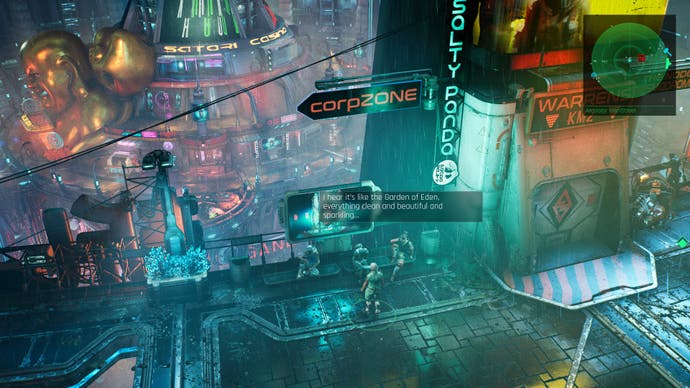
And then there are the technical problems. I hesitate to bring down the hammer here, because my PC is on the rickety side, but if my hardware can run a game on med-high settings it ought to be able to run it without continual crashing, characters getting stuck on the geometry, whole stretches of floorplan taking a moment to load in, and worst of all, special abilities bugging out during combat. At one point the zip of hover traffic kept interfering with the sound of power generators, producing a cacophony suggestive of a lightsaber duel in a washing machine. An hour or so later, the fire button stopped working. Thankfully, these issues apply to enemies too: words cannot express the gratitude I felt towards the finish when an attacking posse abruptly downed tools and sat there, eyeballing me, seemingly as tired of it all as I was.
The more you play, conquering the arcology's upper tiers and toppling its kingpins, the less enthralling this marvelous city becomes. Quests drag you back and forth between far-flung NPCs, your journey interrupted every few seconds by hoodlums arbitrarily defending bits of floor. There's fast travel in the shape of free metro stations and airborne taxis that can be summoned for a negligible fee, but you can only use the central elevators to travel between arcology tiers, which creates more legwork and more opportunities for boring fights. Worst of all, there's no fast travelling from the maintenance districts, docks, plants and factories that account for a majority of dungeons, so if you reach a boss you're under-levelled for and need to juice up your gear, you'll need to trek all the way back to the hub.
Still, it's a relief to return from these gruelling engagements to the major population centres, exploring not so much for sidequests as for fresh sights and sounds, new ways for the setting to express itself. Aliens pumping iron in open air gyms. People mopping up - the RPG bystander's favourite pastime - or kicking vending machines. Club goers throwing shapes (there's a shoot-out that recalls the opening scene from Blade) and drunks wobbling back to the bar. Scientists debating in amongst gleaming centrifuges. All these moving parts sink into the memory where the game's combat and quest elements soon blur into slurry.

By contrast, the world doesn't seem to remember you, for all your burgeoning firepower and tooled-up appearance. Pop off a round and pedestrians scatter, but seconds later it's as if nothing has happened. Respawning gangs prove oblivious to your growing track record for murder. "Want to meet your dead relatives?" they'll squeak, a level 4 to your 20, waggling their dukes like Scrappy Doo squaring up to the Terminator. There's the suggestion of repercussions for killing civilians - the aforesaid wintry mercenary captain will give you an earful about it over the radio. But they never materialise in-game - or at least, they never did for me. Rather than allusions to a morality system a la Fallout, these reprimands come to feel like Call of Duty's hypocritical slaps on the wrist for friendly fire.
News broadcasts during elevator journeys do keep track of your grander acts of mass destruction, and you'll inevitably determine the city's broad fate in the course of the plot. But your status, reputation and choices are never seriously reflected in the chemistry of the spaces you visit, the people you meet. And why would they care? After all, you're just another thug looking to own the universe, grinding your way up to that much-coveted boardroom view. To quote Gibson again, "the street finds its own uses for things". I'm not sure The Ascent's streets have much use for the player.
